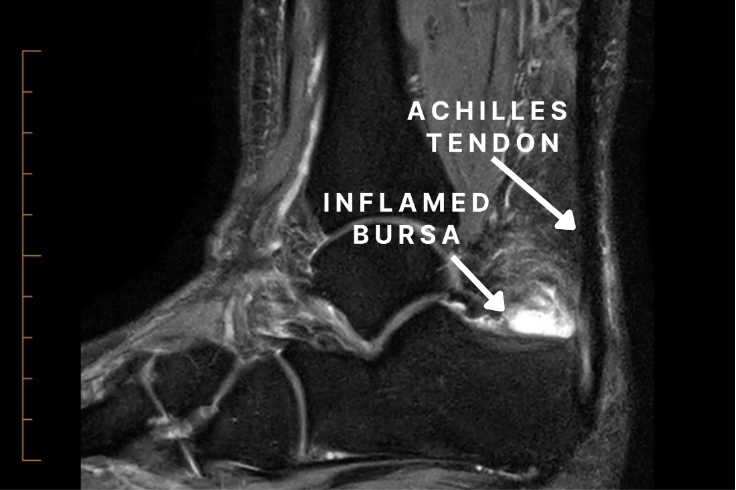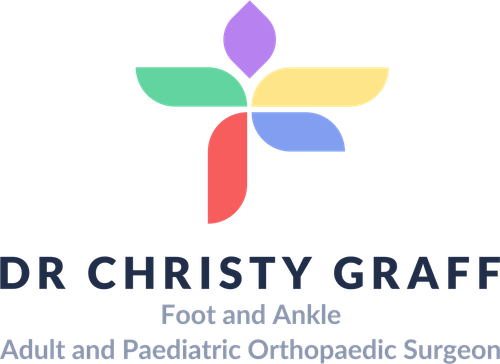Insertional Achilles Tendinopathy Surgery
Insertional Achilles Tendinopathy Surgery Information Sheet
Insertional Achilles Tendinopathy Surgery Procedure
- The surgery involves an incision over the achilles insertion the bone spur and bursa are removed.
- A wedge of bone is removed from the calcaneum, and the calcaneum is shortened to offload the Achilles; the calcaneum is then fixed with a screw.
- A tendon transfer is performed to improve strength and blood supply to the repair, and help the degenerate Achilles to heal

The Hospital Stay
- You wake up with bulky bandages and a boot.
- You will be given blood thinners to prevent DVT and vitamin C to help with wound healing and pain management.
- You will only be allowed to touch your foot to the ground for 2-3 weeks.
- Depending on your balance and strength, you may need rehabilitation postoperatively.
- Buying a second-hand preoperatively (you can search online) and practising at home before the surgery can be helpful; please bring it into the hospital with you. It is easier to use a knee scooter than crutches
When You Go Home
- You will need medications for pain relief.
- You will need to take antibiotics until the wound heals.
- You will need blood thinners and vitamin C daily for 6-8 weeks.
- Please leave all dressings intact until your post op appointment.
- You will get an appointment for your post op appointment in 2-3 weeks where the dressings will be taken down.
- After this, you will be able to shower normally and pat the dressings dry.
Insertional Achilles Tendinopathy Surgery Rehabilitation
All patients are different. These timelines are only a guide; some patients may progress faster or slower than others.
0-2 Weeks
- You will be in a boot.
- You will only be allowed to touch your foot to the ground for balance.
- You will need to bag the leg for showers.
- Pain relief: Please take regular paracetamol with meals and before bed; you may need stronger painkillers as well, especially before bed.
- Please take antibiotics, blood thinners and vitamin C as prescribed.
2-4 Weeks
- Post op appointment for a wound check.
- You will then go back into the boot, but can remove it for seated showering and physiotherapy.
- You can start partial weightbearing in the boot (20-50% body weight).
- Physio for the isometric calf strengthening, hip and knee strengthening and leg lifts, and active range of movement below neutral with physiotherapy.
6-8 Weeks
- Post op appointment to assess range of motion.
- You can weight-bear as tolerated in the boot without wedges.
- Physiotherapy for active plantarflexion and dorsiflexion to neutral, resisted inversion/eversion with the foot in neutral, and proprioception training (pain-free).
9-12 Weeks
- You can wear normal shoes if you are able to fit into them (you may still have swelling).
- You can range the ankle past neutral with physiotherapy
3-6 Months
- You can progress in strengthening and range of motion with pain-free double leg heel raises with physiotherapy.
- From 4 months, light jogging can commence if there is no pain.
- You can walk bare footed.
6-12 Months
- When the leg feels back to normal and the same as the other leg, you can start sport-specific training and heavy labour work.
When Can I Return To Work/School?
- Seated work 4-6 weeks
- Prolonged standing 4-6 months
- Heavy labour work 9-12 months
When Can I Return To Sport?
- Start sport-specific training at 6-8 months.
- Return to sport when the leg is the same as the other side (9-12 months)
When Can I Drive?
- Left foot 2-3 weeks (if driving an automatic)
- Right foot 8-12 weeks
Insertional Achilles Tendinopathy Surgery Risks
- Anaesthetic problems
- Nerve injury
- Blood clots
- Infection
- Stiffness
- Rupture
- Ongoing pain
- Further surgery
If you want more information or have any questions or problems, please contact Dr Graff at
admin@christygraff.com or call the rooms at
0493 461 133.

